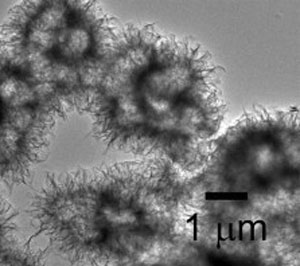| Posted: Jul 23, 2015 |
Coral-mimicking nanoplatelets could emove toxic heavy metals from the ocean
|
|
(Nanowerk News) A new material that mimics coral could help remove toxic heavy metals like mercury from the ocean, according to a new study published in the Journal of Colloid and Interface Science ("Self-curled coral-like γ-Al2O3 nanoplates for use as an adsorbent"). The researchers, from Anhui Jianzhu University in China, say their new material could provide inspiration for other approaches to removing pollutants.
|
 |
| Coral-like nanoplatelets. (© Elsevier)
|
|
Toxic heavy metal ions like mercury, lead and arsenic are released into the water through human activity, including manufacturing and industrial processes. One major source of toxic metal contamination is the ocean. When mercury pollutes the water, plants and animals absorb it. The mercury builds up in the food chain, ultimately resulting in toxic fish. According to the WHO, between 1.5 and 17 in every thousand children living in selected subsistence fishing populations showed cognitive impacts caused by the consumption of fish containing mercury.
|
|
Heavy metals are also toxic to corals: even at low concentrations, small amounts of heavy metal pollution can kill corals. This heightened toxicity is due to coral being very efficient at collecting, or adsorbing, heavy metals. The researchers behind the new study have taken inspiration from this and developed a device that mimics the way coral adsorbs heavy metals.
|
|
Dr. Xianbiao Wang and colleagues have made coral-like nanoplates using aluminium oxide, with the aim of adsorbing mercury from water. Aluminium oxide has previously been used to remove pollutants, but the structure of the material has not been optimal, so they have not performed very well. The new nanoplates curl themselves up into a coral-like structure, which behaves in a similar way to real coral, making the material more effective.
|
|
“Adsorption is an easy way to remove pollutants from water, so developing new products that can do this is a big challenge in environmental remediation,” said Dr. Xianbiao Wang, one of the authors of the study from Anhui Jianzhu University in China. “The chemical and physical structure of such products is very important, it is interesting to design and fabricate adsorbents with different structures to see how they behave. In particular, materials that mimic biological adsorbents like coral have potentially huge applications.”
|
|
The researchers tested the coral-like nanoplates on removing mercury from water. They found that the coral-like structure removed around 2.5 times more mercury from water than the traditional aluminium oxide nanoparticles.
|
|
“We are very excited about the results, which provide a good example for the production of coral-like adsorbents,” said Dr. Wang. “We hope our work provides inspiration for more research into the development of materials that mimic biological organisms.”
|

